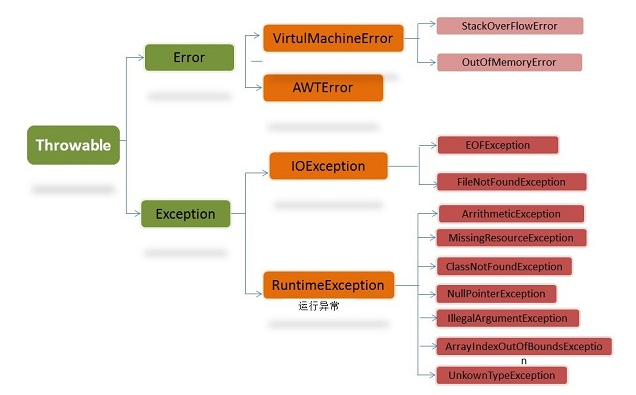Java异常
异常机制
异常体系结构
Java把异常当作对象来处理,并定义一个基类java.lang.Throwable作为所有异常的超类
Error通常是致命的错误,由JVM生成并抛出
Exception可以被程序处理
异常处理机制
package com.exception;
public class Test {
public static void main(String[] args) {
int a = 1;
int b = 0;
System.out.println(a/b);
}
}
// 出现异常:ArthmeticException: / by zero
package com.exception;
public class Test {
public static void main(String[] args) {
int a = 1;
int b = 0;
int c = 0;
//类似if else,可以有多个catch 有多个catch时,catch括号里的异常类型要从细分的到大的
try{//try监控区域 代码块中的异常
System.out.println(a/b);
}catch (ArithmeticException e){//捕获异常
//如果try里面的代码块出现了catch括号里的异常,就会执行catch代码块的内容
System.out.println("程序出现异常,变量b不能为0");
}finally{
//无论程序是否出现异常,都会执行finally代码块 可以不要finally,必须要有try catch
System.out.println("finally");
}
//捕获异常快捷键:选择需要监控的代码 ctrl+alt+t
try {
System.out.println(a/c);
} catch (Exception e) {
e.printStackTrace(); //打印错误的栈信息 把这个异常打印出来
} finally {
}
}
}
package com.exception;
public class Test2 {
public static void main(String[] args) {
//抛出异常
try {
new Test2().test(1,0);
} catch (ArithmeticException e) {
System.out.println("ArithmeticException");
}
}
//方法上抛出异常
public void test(int a, int b) throws ArithmeticException {
if(b == 0) {
throw new ArithmeticException(); //主动抛出异常,一般在方法里使用
}
}
}
自定义异常
java给的异常其实已经够用了
package com.exception.demo02;
//继承异常类 就获得了一个自定义异常类
public class MyException extends Exception {
//传递数字 >10 报异常
private int detail;
public MyException(int a) {
this.detail = a;
}
@Override
public String toString() {
return "MyException{" +
"detail=" + detail +
'}';
}
}
package com.exception.demo02;
public class Test {
//创建一个可能会存在异常的方法
static void test(int a) throws MyException {
System.out.println("传递的参数为:"+a);
if(a >10) {
throw new MyException(a);
}
System.out.println("OK");
}
public static void main(String[] args) {
try {
test(11);
} catch (MyException e) {
System.out.println("MyException:"+e);
}
}
}
总结
- 处理运行时异常时,采用逻辑去合理规避同时辅助try-catch处理
- 在多重catch块后面,可以加一个catch(Exception)来处理可能被遗漏的异常
- 对于不确定的代码,也可以使用try-catch,处理潜在的异常
- 切忌只是简单的调用printStackTrace()去打印输出
- 尽量添加finally语句块去释放占用的资源





 浙公网安备 33010602011771号
浙公网安备 33010602011771号